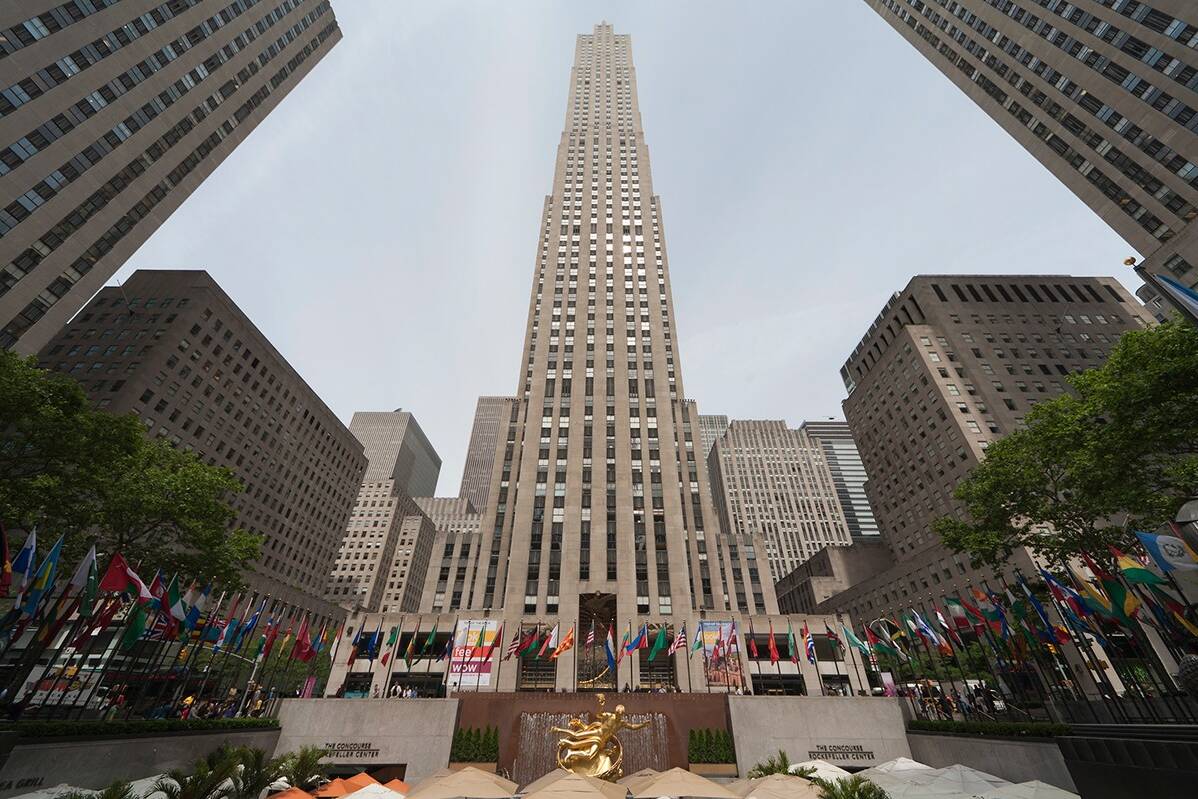The Empire State Building has captivated visitors for over nine decades. Rising 1,454 feet over Midtown, this art deco masterpiece offers unparalleled views that highlight New York City’s eclectic architecture and dynamic cityscape. Let’s take a fascinating look through the building’s history, its place in pop culture, and the sights visible from its world-famous observatories.
Table of Contents
Empire State Building Construction & Architecture
Early Planning and Designs
Can you envision what New York City was like in the late 1920s? Back then, the iconic Waldorf-Astoria Hotel sat on the site where the Empire State Building now stands tall. But in 1928, the hotel owners sold the property for $14-16 million. The buyer? A group called Empire State Inc., with former New York Governor Al Smith at the helm. Their vision? To construct a towering 80-story, 1,000+ foot skyscraper that would claim the crown as the world’s new tallest building. The ambitious project truly captured the zeitgeist of 1920s America.
Several revisions later, the final plans expanded to 102 floors soaring 1,250 feet high. The renowned architecture firm Shreve, Lamb and Harmon spearheaded the art deco design. Inspired by contemporary structures like the Daily News Building, they devised a sleek shape with distinctive setbacks. With a budget of $50 million and an unbelievable timeline of just 18 months, it was full steam ahead!
Nuts and Bolts: Building a Modern Marvel
Let’s fast-forward to March 1930 when demolition and excavation commenced on the old hotel site. Construction kicked into high gear, with crews working round the clock erecting over four floors per week! The project required tons of materials like limestone, granite, steel, aluminum, bricks, and glass. Contractors like Starrett Brothers and Eken coordinated delivery of truckloads of supplies daily. Innovations like temporary rail tracks and hoists maximized efficiency. By October, steelwork reached the 64th floor. And by April 1931, a mere 13 months from groundbreaking, riveters drove the final gold-colored ceremonial rivet home. The ambitious Empire State Building officially topped out ahead of schedule and under budget, accomplishing one of the fastest “race into the sky” construction feats ever.
Art Deco Design Details
Crowning the Empire State is its sleek art deco tower and spire. The façade itself contains over 6,500 windows arranged in vertical sections with chrome-nickel steel mullions. This helps create a striking, slender pencil-like silhouette. The building’s series of setbacks allowed for maximum light, air circulation, and open city views from the interior spaces. Limestone imported from Indiana gives the Empire State its iconic golden-hued blonde color. And special floodlights accentuate its crown after dark.
Inside, the Fifth Avenue lobby entrance still captivates with its soaring three-story height and dazzling aluminum relief sculpture depicting the skyscraper. Marble, metalwork, glazed brick, and terracotta details retain the original 1930s style. And dotted throughout the floors are nearly 2,000 storefronts and shops ringing the central office space.
From the needle-like mast to the sleek limestone and chrome exterior to the glorious art deco lobby, the Empire State Building remains a breathtaking testament to 1930s modernist architecture.
Interior Infrastructure & Observatory Decks
Of course, the Empire State Building wouldn’t be complete without its famed viewing platforms. On the 80th floor, interactive exhibits and a panel of the skyline recreated in 5,000 crystals now greet modern visitors. Heading up to the 86th floor, the open-air observation deck offers panoramic city vistas. Finally, the renovated 102nd floor observatory debuted floor-to-ceiling glass windows in 2019 that completely immerse you in views of the Manhattan horizon. Broadcasting equipment and antennas cap the mast and spire above.
Originally coal-fired boilers provided heating, later upgraded to cleaner, quieter modern systems. An electrical substation and generators offer backup comforts like air conditioning, light, hot water and elevators even in blackouts. Talk about forward-thinking planning and design back in 1931!
Views from the Empire State Building
Of course, the main attraction luring over 4 million visitors a year are the unparalleled views. Let’s preview some sights in each direction from the world’s most iconic vantage point:
360° Orientation
Getting your bearings straight is key before you begin exploring the landscape unfurling around you. Heading north reveals Central Park and the Upper West Side neighborhoods. The famous East River, Queensboro Bridge and Citigroup Building sit prominently northeast. Glancing right finds the green expanse of Bryant Park, while southward sits the Garment District and Chelsea neighborhoods all the way to Lower Manhattan. Finally, the Hudson River flows due west beyond bustling Hudson Yards.
North: Upper Manhattan Landmarks
Looking north, you can glimpse Yankee Stadium hovering above industrial Harlem in the hazy distance. Closer by lies Morningside Heights, home to Columbia University and the soaring Cathedral of St. John the Divine. Grand buildings like The Ansonia dominate the Upper West Side, while verdant Central Park stretches for miles. On a clear Fall day, you may even spot vibrant foliage blanketing the park.
Of course, the legendary skyline steals your gaze northeast. The Chrysler Building still gleams like a sentinel keeping watch. Rockefeller Center’s Art Deco towers poke between Midtown giants, as the tip of the One World Trade Center Freedom Tower pierces the heavens beyond the MetLife and Citigroup buildings. It’s incredible grasping the sheer scale and variety!
East: Bridges, Buildings and Boroughs
Glancing right, you behold the East River carving its way between Manhattan and Brooklyn/Queens. The iconic Queensboro Bridge stretches across the waterway, alive with traffic. Roosevelt Island and older Victorian structures dot the riverbanks. The colossal Citigroup Building dominates this side of Midtown, its unique roof sloping towards Lexington Avenue behind it.
Further south, Lower Manhattan almost resembles a forest of glass, steel and stone. The Financial District contains soaring towers like 70 Pine Street flanked by early 20th century icons. The Statue of Liberty lifts her golden torch above the harbor southward. And rising behind, Silvercup Studios’ namesake sign winks from across the river in Long Island City, Queens.
South: Herald Square to Lower Manhattan
Scanning south from the Empire State Observatory takes you over the Garment District and Chelsea neighborhoods, then across Greenwich Village before reaching the canyons of Lower Manhattan. In between, you can spot Madison Square Garden just above Koreatown’s flatiron buildings. The shadows of New York University and hip East Village stand out. Farther down, SoHo’s cast-iron facades mix with modern giants like One and Three World Trade Center. FiDi’s stone temples give way to the Battery’s leafy park tipped by Ellis Island and the Statue of Liberty’s crown.
This view highlights New York City’s eclectic architecture, from the Midtown bridges, the village’s brownstones and the Financial District’s soaring new skyscrapers. The green oasis of Battery Park even brings nature into this concrete kingdom.
West: Waterfront from Hudson Yards to New Jersey
The Hudson River panorama facing New Jersey represents NYC’s other shoreline. In the foreground, Hudson Yards now dominates the scene as the new West Side mega-development. Its centerpiece, the angular Vessel climbing structure, looks tiny from this height! Beyond the rail yards, you can trace the Jersey City waterfront lined with gleaming towers like Goldman Sachs, as the Palisades cliffs loom on the horizon.
Dining Near the Empire State Building
The Empire State Building’s prime location puts it within walking distance of some of NYC’s hottest restaurants. Indulge in incredible eats without ever traveling far, including:
Sesamo Empire State Building – This modern Asian-Italian spot delights Hell’s Kitchen crowds with creative takes on chicken, eggplant and more using seasonal ingredients.
Wolfgang’s Steakhouse – Carnivores flock here for Porterhouses, creamed spinach and power lunches in an old-school steakhouse setting.
Koreatown – New York’s vibrant K-Town kicks off two blocks west with Korean BBQ spots like Kang Ho Dong Baekjeong dishing up banchan, noodles and karaoke.
Eataly – A quick taxi ride south, Eataly’s Birreria exudes Italian flavor with house-brewed beer and wood-fired pizza against skyline views worth the trip!
With award-winning global eats surrounding its very doorstep, visitors can refuel on fabulous flavors between adventures at Gotham’s greatest art deco icon. The Empire State Building certainly anchors itself in a prime NYC location in more ways than one!
Broadcasting History & Communication Infrastructure
Of course, the Empire State Building is more than just a pretty façade. As one of New York City’s original supertall skyscrapers, its central location and lofty height have lent themselves to infrastructure and broadcast needs since Day One:
Antennas Crown NYC’s Radio & TV Airwaves
After opening in 1931, the building’s mast was briefly considered for docking dirigibles before technicians began installing equipment for broadcasting in the 1930s. By 1950, a 200-foot transmission tower topped the spire to transmit signals for all the city’s TV and radio stations. Broadcast antenna now ring up and down the entire mast from the 80th floor up past the 102nd floor observatories. Pretty impressive, considering the infrastructure meshes seamlessly with visitors to enjoy those fabulous views.
Impact of the 1960s World Trade Center Construction
The Empire State Building enjoyed three decades as New York City’s tallest structure and broadcast beacon. But the World Trade Center Twin Towers exceeded that height upon completion in 1970. Many networks relocated transmission facilities which impacted the Empire State’s communications and revenue. However, the Port Authority agreed to install replacement antenna infrastructure at the World Trade Center to appease unhappy Empire State owners.
Significance as Broadcast Site After 9/11 Attacks
Of course, the unthinkable happened on 9/11/2001 when terrorism destroyed the World Trade Center. Broadcast signals across the city temporarily went dark for 10 days. Luckily, technicians swiftly reestablished antennas atop the Empire State Building to restore this vital communications capacity until permanent antenna could be installed at One World Trade Center in the 2010s. So the iconic art deco tower served as New York City’s makeshift transmission site in a time of tragedy, keeping the public informed during recovery efforts.
Modern Lighting & Sustainability Upgrades
While honoring its history, the Empire State Building stays continuously modernized as well. Sustainability initiatives have upgraded windows, heating, and lighting for maximum efficiency. LED bulbs control the iconic tower light shows, using 80% less energy! And a $165 million renovation of observatories debuted in 2019. State-of-the-art exhibits now immerse visitors in the thrill of ascending and taking in the cityscape surrounding the famous Empire State.
Pop Culture Symbolism
Beyond infrastructure improvements, the Empire State Building itself has become embedded in pop culture and the public consciousness over nine decades:
Iconic “King Kong” Movie Debut
Can you visualize the climax of King Kong, when planes attack the giant ape clutching Fay Wray atop the Empire State Building? The 1933 movie cemented the art deco tower as the archetypal skyscraper. Countless films have capitalized on the building’s towering fame since.
Appearances Across Film, Art, Literature & Music
From Independence Day alien battles to Sleepless in Seattle romance, the Empire State Building reliably delivers silver screen drama and comedy. Andy Warhol captured its celebrity status in an eight-hour silent film called Empire. The skyscraper even dials up the tension in video games like Crysis 2 when aliens attack the observatory deck!
On canvas, photographs, tourism posters and literature, artists worldwide feature the Empire State Building visual shorthand for conveying New York City’s excitement. And musicians from Alicia Keys to LCD Sound system name-drop the landmark in lyrical odes to the Big Apple.
Architectural Influence Across the Globe
Beyond fame, the building also leaves a structural legacy. At 102 stories, it proved supertall skyscrapers could be built beyond previous assumed limits through modern mass-production methods. The design influenced towers globally, like the Financial Insurance Center in LA. Overseas, everything from the Empire Tower replica in the New York-New York Vegas hotel to China’s CITIC Plaza emulates aspects of the art deco classic. While the Empire State Building no longer holds height records, its Depression-era innovation and style still awe and inspire today.
Celebrity Visitors & Public Fascination
From publicity events like the annual Empire State Building Run-Up race to movies on the 80th floor, the global icon continues attracting public fascination today. Celebrities like Taylor Swift and royalty including Prince William actively seek out the VIP treatment and world-famous views. Each year, hundreds of pop culture events and films actively capitalize on the landmark’s enduring intrigue and sway!
Preserving an Historic Landmark
Given the Empire State Building’s significance, meticulous preservation ensures it endures for new generations to admire:
Landmark Protection Status Safeguards Integrity
Since the early 1980s, New York City officially protects the Empire State Building as a historic city landmark through its preservation commission. And in 1986 the art deco icon gained National Historic Landmark designation from the Department of Interior for its architectural merits. These oversight bodies help ensure modifications to the building uphold and honor is original grandeur and design intent.
Renovations & Upgrades Continually Enhance Visitor Experience
The official oversight comes alongside ongoing revitalizations by ownership groups over the decades to actively maintain and modernize infrastructure. For example, a comprehensive $550 million update from 2009-2019 refurbished building systems for sustainability while adding new observatory galleries. Keeping the site immersive and thrilling for visitors is key, and recent renovations restored the iconic mooring mast and external floodlighting to better showcase its sleek art deco design.
Empire State Realty Trust’s Active Modern Management
Since taking ownership control recently, the Empire State Realty Trust continues actively managing and leasing out office space inside the storied building. Broadcasting stations still transmit signals from the mast, alongside cell phone and other infrastructure equipment. Plus special lighting bathes the tower in seasonal colors. Balance between modernization, infrastructure, entertainment and preservation persists under the current stewardship.
Future Visions
As times and architectural feats advance, the nearly century-old Empire State Building pushes innovation in energy efficiency and visitor exhibits to secure its place despite recently surrendering NYC’s tallest title. Flexible indoor spaces may potentially support new uses we can’t yet envision for decades further down the road. No matter what surrounds it going forward, the sleek art deco spire shall remain the quintessential focal point of the Manhattan skyline just as King Kong envisioned.
Conclusion
The Empire State Building has rightfully earned its reputation as an international emblem of New York City. Beyond impressive statistics like its 1,454 height and 1931 construction speed records lies cultural weight; from iconic movies to its place in the NY skyline to broadcast history. Views from its observatories also showcase NYC’s eclectic architecture and dynamic landscape unfurling in every direction. Through ongoing preservation efforts, this sleek art deco tower stays forever young at nearly 100 years old. With its prime location, the fun hardly stops after you descend the Empire State Building’s majestic heights. This linked guide covers details on more nearby shopping, Midtown attractions, Broadway theaters, best skyscraping views, museum row on the Upper East Side, urban parks and nightlife excitement – really anything in the Empire State vicinity!
So next time you’re snapping that legendary city panorama, take a moment to appreciate all the rich history, structural innovation and visual excitement the Empire State Building represents. No matter your vantage point, it shall endure as Gotham’s chief art deco Cathedral of Dreams!





